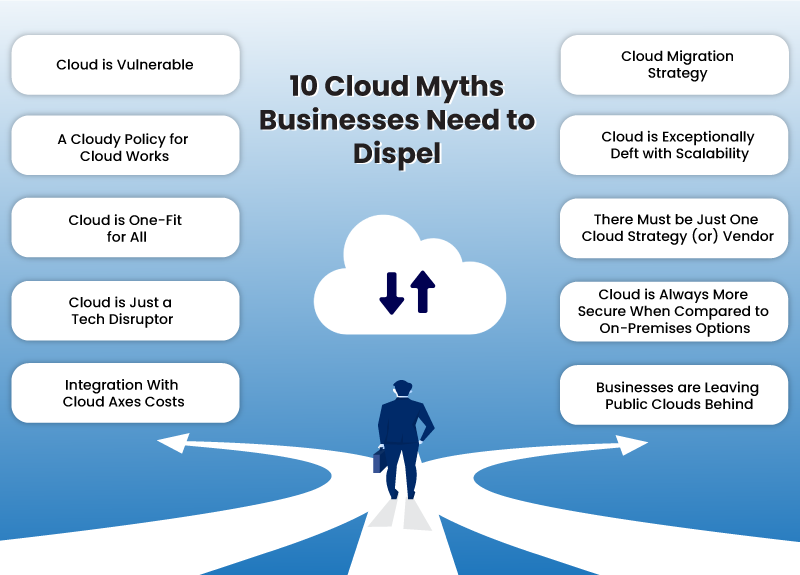
Most companies are increasingly integrating Cloud tech with their business solutions. Although Cloud technology is transforming global business, some entrepreneurs continue to harbor doubts. This fear of the unknown has spawned many myths that continue to shroud evolutionary tech.
These myths hinder businesses from harnessing Cloud computational powers. Due to this fear of the unknown that most users have towards disrupting technologies, the myths continue to pervade cyberspace despite Cloud tech being mainstream now.
In cloud computing, myths still abound. These myths have the potential to harm businesses, stifle innovation, and incite fear. Despite the fact that the advantages of cloud computing have significantly increased in popularity over the past five years, some of the fallacies that persisted at the time of its introduction still exist today. Additionally, new misconceptions have emerged.
Instead, the cloud transition is a network of virtually interconnected data services that can access online. Clouds can be public, shared by many organisations, or private, accessible only by one particular organization. In addition, most businesses now employ a hybrid cloud storage and access approach that combines many cloud types.
A boundary between the customer and the service provider exists in cloud computing, which is about delivering capabilities as a service. Unfortunately, numerous misconceptions and myths in this atmosphere need to be dispelled.
Cloud computing is praised for its potential to promote “speed-to-market” and business agility. This is because cloud adoption enables businesses to swiftly test and even implement new solutions without incurring high initial expenses, supporting rapid experimentation and innovation. Different systems and different behaviors and bringing them all together in an engagement cycle can be wrapped up in a highly dynamic manner by the cloud transition. Cloud migration services allow new ways for consumers to engage with technology, expand collaboration throughout the value chain and innovate the fundamental business models of organizations.
While it is pertinent to know the depth of the pool before you dive in, having a misconceived notion about the same is perilous. As the Cloud arena ushers in the new digital era, let’s look at the myths that continue to bog it down.
Consult our Cloud Consulting Expert
10 Cloud Myths Businesses Need to Dispel

1) Integration With Cloud Axes Costs
Cloud tech is often perceived as a tool that reduces company expenses by a great deal. The myth germinates out of the sales pitch that cloud infrastructure providers sell you. Cloud tech is projected to reduce costs on the front of the resource with its scalability features and on-demand servers. However, harnessing the Cloud brings its own set of costs.
Although each business has its own set of requirements that define the Cloud adoption expenses, these Cloud costs can be trimmed down by an appropriate governance policy. A good governance policy will ax expenses without stunting the innovation of the company.
By etching the Cloud governance policy and understanding the operational costs, entrepreneurs can implement a Cloud solution apt for their business. Although Cloud’s costs may deter others, the advantages of the Cloud outweigh the operational expenditures.
The Pay-as-you-go model, scalability, ease of development, and deployment are just some of the many benefits users enjoy. The Cloud giants such as AWS, Azure, and GCP sweeten the deal by doling out industry-specific Cloud subscriptions, which allow the users to enjoy and pay for the benefits they use.
2) Cloud is Just a Tech Disruptor
No, Cloud is not just a tech disruptor. It is much more than that. Cloud is a productivity tool that enhances the user experience while reducing undesired expenses. It transforms how to program coders develop software and how the same solutions are deployed across servers globally. Without adding or modifying the code, the business solutions are scaled up by the Cloud adoption.
After Cloud tech entered the scene, business operations were propelled to new heights. With the transformation that Cloud has ushered in, it would be lamentable if one says Cloud is a tech disruptor. Cloud migration services is a force that has not just impacted the work processes but global culture, as well.
3) Cloud is One-fit For All
Cloud is a tool of immense potential. However, one ought not to integrate every application with cloud security automation. There will always be certain applications that don’t require Cloud optimization. Secondly, one needs to consider the integration challenge that legacy applications pose. Lacing legacy apps with modern-day Cloud would be unwise as most of such apps were not designed for the latter.
4) A cloudy Policy for Cloud Works
Wanting to perfect Cloud integration without a strategy would be a counterproductive approach. Most initiate the moving to cloud journey without a plan or approach. This results in plenty of chaos after the organization migrates to Cloud optimization.
A detailed policy will help you realize the business goals. By consulting with DevOps teams and keeping the goals in mind, one ought to etch out a Cloud governance policy. The policy should address Cloud usage terms and ought to have robust identity access management.
5) Cloud is Vulnerable
Security is always a concern. Most people opine that on-premises infrastructure is safer than the Cloud. However, that is untrue. Cloud platforms are ingrained with state-of-the-art security. This vital safety aspect is one of the factors which promotes Cloud migration.
6) Cloud Migration Strategy
It is a misconception to assume that once the organization migrates to cloud native applications, the job is done. In reality, the true potential of the Cloud is harnessed when the organization understands the Cloud’s operating model and uses it to meet its expectations. The migration is just the beginning of the journey. Once you have moved there, you need to perceive the well-being of the applications and which programs can perform better with Cloud benefits such as automation. One ought to monitor the changes that the integration has yielded and work towards nullify the unwanted ones.
7) Cloud is Exceptionally Deft with Scalability
Yes, cloud is highly scalable, and businesses are benefiting from it significantly. Previously, an organization would have to jump through many hoops to scale up (or down). However, with Cloud, users have to convey their requests, and the cloud infrastructure providers would scale in no time. The best Cloud techs come with an auto-scalability feature, allowing the cloud migration services to scale as per the demand. This extra-mile effort of the Cloud tech providers has lent finesse to the scalability feature.
8) There Must be Just One Cloud Strategy (or) Vendor
Even if multi cloud strategy is receiving more attention today, many businesses still want simplicity. A cloud strategy must be built on the understanding that cloud computing is not simply one thing. Cloud services are extensive and cover a range of levels, models, applications, and scopes.
A cloud strategy must be flexible enough to support expanding cloud services. The company needs to understand that relying on only one provider to supply everything will be difficult. A single cloud migration plan makes sense only if a decision framework that anticipates and accepts various answers is used.
9) Cloud is Always More Secure When Compared to On-premises Options
Cloud computing was once thought to be less secure than on-premises options. But there haven’t been many security lapses in the public cloud, and most still entail incorrect cloud service settings. As a result, most cloud service companies now make significant investments in security because they understand that doing otherwise would put their operations in danger.
However, this does not imply security in the cloud in particular. Both the provider and the customer share responsibilities for cloud security automation. Both the assumption that cloud infrastructure providers are secure and the assumption that they are not should be avoided by CIOs. As cloud provider security levels vary, evaluate your current capabilities and those of your potential provider and hold both to fair standards.
10) Businesses are Leaving Public Clouds Behind
The misconception that workloads are returning from cloud optimization is mostly made up of legacy suppliers that stand to gain financially from it being authentic. The majority of businesses haven’t actually switched cloud workloads back. Of those who have relocated, the majority are coming from SaaS, colocation, and outsourcers rather than cloud infrastructure as a service (IaaS).
This does not imply that cloud migration strategy is successful. However, instead of abandoning their cloud strategy and relocating apps to their original location, firms are more inclined to deal with issues as they emerge.
In conclusion

Overall, cloud migration plan is a vast ocean that is yet to be explored. Whenever unknown factors are involved, the fear laced with creativity gives way to myths. However, as we have observed, most of the myths are unfounded and nothing more than impediments. One ought not to fall prey to these baseless myths.
If anything, debunking or ascertaining these myths must be a priority. Organizations ought to research and consult with experts in the field. Bear in mind that myths should only amuse you, not make you a laggard in the digital pace.
Veritis, the Stevie Award winner, provides reliable, robust, and cost-effective solutions. Embrace the cloud with a unique strategy by partnering with Veritis to secure your future.
Explore Cloud Services Got Questions? Schedule A Call
More Articles:
- IAM Best Practices for Optimal Cloud Security
- Best Practices that Lead to Good Cloud Governance
- Cloud Implementation Services: Strategy, Solutions and Benefits
- Cloud Computing in Healthcare: Looking for Security Advantage?
- How Cloud Computing Maturity Model (CCMM) Helps?
- 6 Ways AIOps Optimizes Cloud Security
- Cloud Security Automation: Best Practices, Strategy, and Benefits